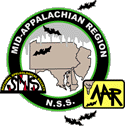
|
Mid-Appalachian Region of VOLUNTARY CAVING BAT MORATORIUM LIST The Nittany Grotto, the NSS, and other grottos are organizations that are dedicated to cave conservation. We as cavers support and campaign for the protection of cave resources, mineral, hydrological, and biological. To this end Nittany Grotto members support a voluntary moratorium on caving in the following caves during periods critical to Pennsylvania's bat populations. This is per motions passed in Nittany Grotto meetings to formally adopt a stance to protect threatened, endangered, and large populations of bats. The Nittany Grotto encourages other grottos and caving organizations within the MAR region and within other regions of the country to adopt and publish this list in both paper and web format. These measures are the action of the Nittany Grotto and may not represent policies taken by landowners. Some of these caves are closed year around, some have gates that are locked in winter, and some have no access restrictions. The important part is that we as cavers of the caving community are acting as responsible cavers and support and educate others on the need to NOT visit these caves between September 1st and May 1st of each year. This gives us cavers a four-month period where bats are not impacting your choice of what cave to visit. In Pennsylvania, bats only use caves for Fall swarming and hibernating. (The exact purpose of swarming is speculative in nature but involves teaching young where the caves are and mating/courting behaviors.) To the south in West Virginia and Virginia, bats will use caves to rear their young (Pennsylvania caves are too cold for this), which means caves are closed for the summer as well as Winter when both hibernating and maternity colonies use a cave.
Bat populations are constantly changing. If you enter a cave not on this list and see significant numbers of bats, please abort the trip and send a copy of the trip report to The best thing we can do to help protect bats is to simply leave them alone. As we learn more about these specific sites, closure dates may change. Some caves may not have Fall swarms, some may have populations that stay in hibernation further into Spring. With luck, funding, and research, these dates will become more cave specific. These dates represents a "win-win" situation: we cavers get to see the caves and the bats are protected. Only by supporting and protecting cave resources will cavers maintain their reputation as a major conservation force. This list is organized by county (Pennsylvania); mines are not included unless they intersect significant cave passage that have "solutional" characteristics.
| ||
 | ||
|
Contact: MAR Webmaster Email:  mar.caves.org Copyright © 2000-2025. All rights reserved. |

© CAVR 2025 | |
 bats@batmanagment.com
bats@batmanagment.com